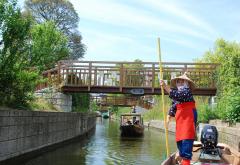Katōzu’s Jūnikyō
更新日:2021年6月18日

In 1960, the area stretching from the Hokusō region to southern Ibaraki Prefecture was established as Suigo Tsukuba National Park. At the southernmost end of the park is Katori City. Located within this part of the city is Katōzu’s Jūnikyō, a riverside district that has been famous since long ago. Katōzu’s Jūnikyō is part of a vast paddy field located between the Tone River and the Hitachi-Tone River. Canals, collectively known as Enma, spread throughout this area, and boats would go back and forth along the canals to get from one house or rice paddy to another. Spanning over these canals were 12 simple single-plank bridges that connected houses to each other. As such, these bridges became known as “Jūnikyō (lit. Twelve Bridges).”
Today, you can tour Katōzu’s Jūnikyō in a Japanese flat-bottomed boat steered by a female skipper, passing under these bridges as you move along the canal. It is especially lively from late spring to summer, when the Siberian irises and Japanese irises bloom at Lake Yodaura’s Suigo Sawara Ayame Park, where the boat arrives and departs. During this season, hydrangeas also blossom along the waterfront and souvenir shops open, welcoming boat passengers.
Information
Closed
Irregular
Fare
One boat, up to four people: 7,200 yen
1,800 yen/person for groups of more than four people
Access
By taxi:
- Approx. 15 min by taxi from JR Sawara Station
By car:
- Approx. 30 min from Sawara-Katori IC on the Higashi-Kanto Expressway
- Approx. 30 min from Taiei IC on the Higashi-Kanto Expressway
- Approx. 25 min from Kōzaki IC on the Ken-O Expressway
Nearby Tourist Attractions
![]() National History Museum and Institute, Chiba – Ōtone Branch(外部サイト)
National History Museum and Institute, Chiba – Ōtone Branch(外部サイト)
Sawara’s Historical District (Important Preservation District for Groups of Traditional Buildings)
Inoh Tadataka’s Former Residence
etc.
Contact Information
Oku-Suigo Tourism Cooperative
Phone: 0478-56-2280
このページの作成担当
商工観光課 観光班
〒287-8501 千葉県香取市佐原ロ2127番地 (市役所3階)
電話:0478-50-1212
ファクス:0478-54-2855

